
After moving to the US from China, one of the things I’ve missed the most is the diversity of vegetables. Over the years I’ve learned to use vegetables I can find in the grocery store to replace Chinese vegetables. But I admit, many of them are hard to replace.
I’ve been eating winter melon stir fry since childhood. It’s an easy homestyle dish that my mom makes often in winter. And I find it super hearty whenever I cook it in my own kitchen.
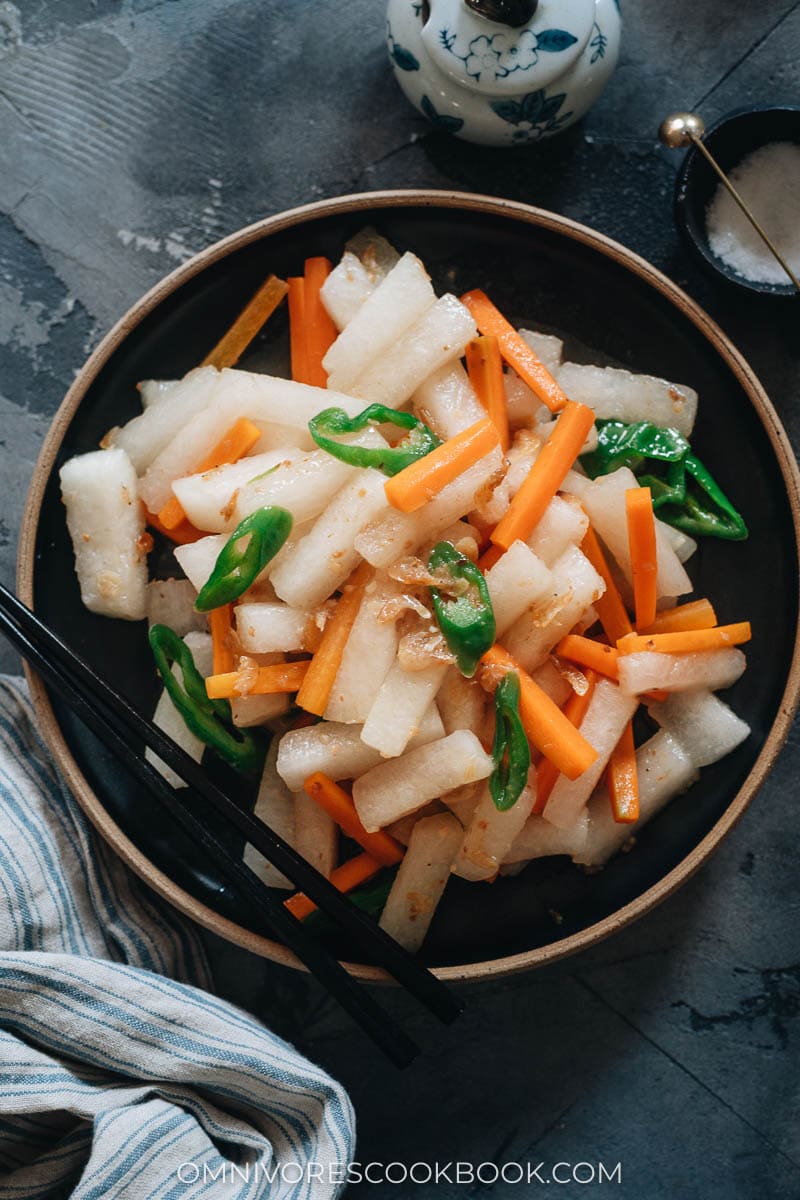
What is winter melon
Winter melon, or Dong Gua (冬瓜), is one of my favorites. In winter, my mom usually cooks it in a Chinese winter melon soup with meatballs. I also love to use it in hot pot.
Winter melon is a type of gourd that has a texture that’s very different from other squashes and melons. It is huge, most of the time much bigger than a watermelon. It has a tough skin, very thick white flesh, and big seeds. Once cooked, the flesh turns tender and has a very mild and lightly sweet flavor. The texture of the cooked melon is somewhere between summer squash and daikon radish.
Due to its mild taste, winter melon is perfect for soup, stew, and stir fry, because it will taste like whatever you season it with.

How to prep and cut winter melon
Most winter melons on the market are pre-cut and wrapped in individual packaging, because the melon is so big and one person can hardly eat a whole melon. But if you happen to get a whole winter melon, you’ll need to cut it crosswise into thick wheels, so it’s easy to peel and deseed.
The most common cuts on the market are the wheel- and half-wheel-shaped cuts. But you might find some cut into wedges. Either way, you will need to remove the seeds and the soft tissue around them. Then you will need to use a knife to peel off the skin by about 1/4” (1/2 cm). Do not use a peeler because the flesh that’s attached to the skin is very tough and hard to cook through.
Once deseeded and peeled, you can chop the melon flesh into whatever shape you prefer.
My favorite way is to cut the melon into thick batons for stir frying, and thick slices for soup and braised dishes.
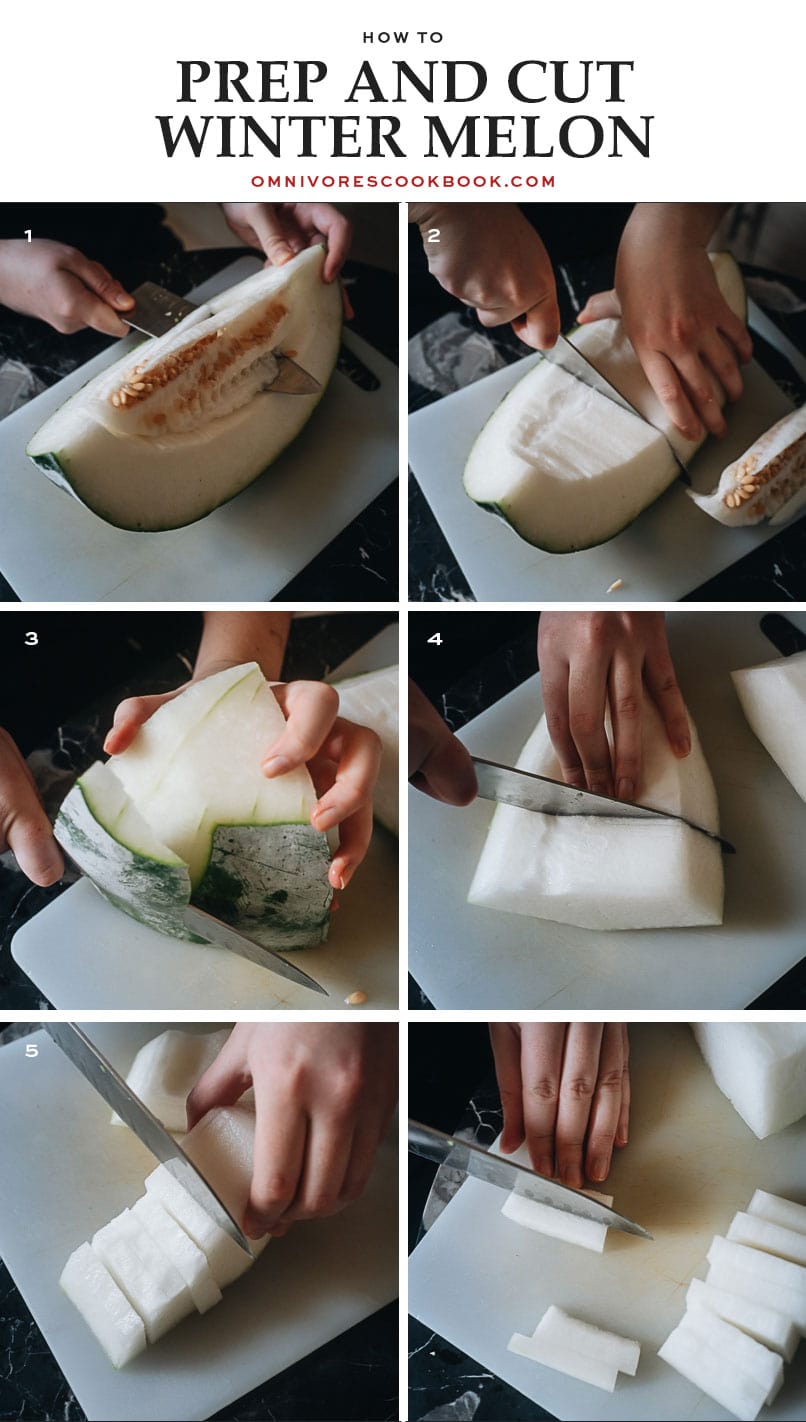
Ingredients
Winter melon stir fry only requires a few ingredients and is easy to prepare. In this recipe I included carrots and a mild pepper to add color to the dish and make the texture more interesting. However, it’s totally fine to skip these two ingredients and focus on the winter melon.
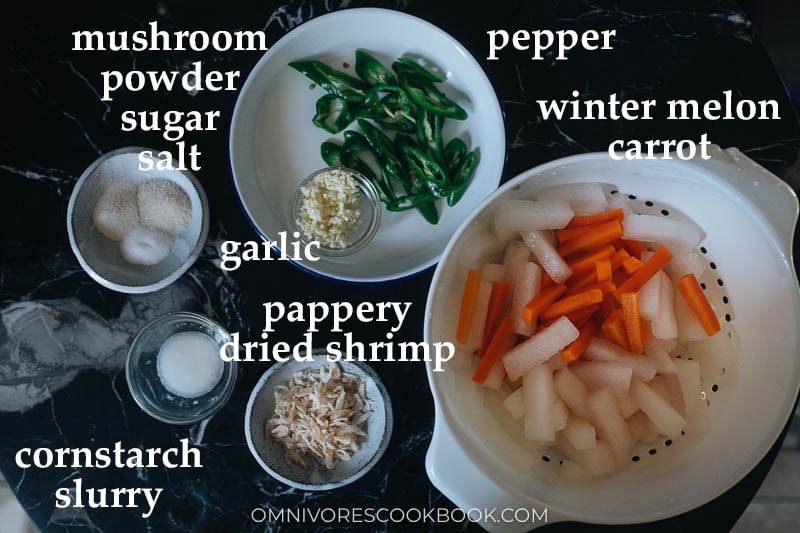
How to use dried shrimp to add umami
The highlight of this recipe is the papery shrimp (虾米皮), a type of dried shrimp that’s commonly used in Chinese cooking to add a seafoody umami and saltiness. They are very tiny dried shrimp that have very soft shells. Compared to the bigger and meatier dried shrimp, you don’t need to pre-soak the papery shrimp before cooking.
The way you use papery shrimp is similar to aromatics. You will need to fry them with a bit of oil to release the fragrance and crisp it up a bit, then add the other ingredients.
The papery shrimp add an intense seafood flavor and saltiness to the winter melon, making the plain melon extra rich and delicious to serve with rice.
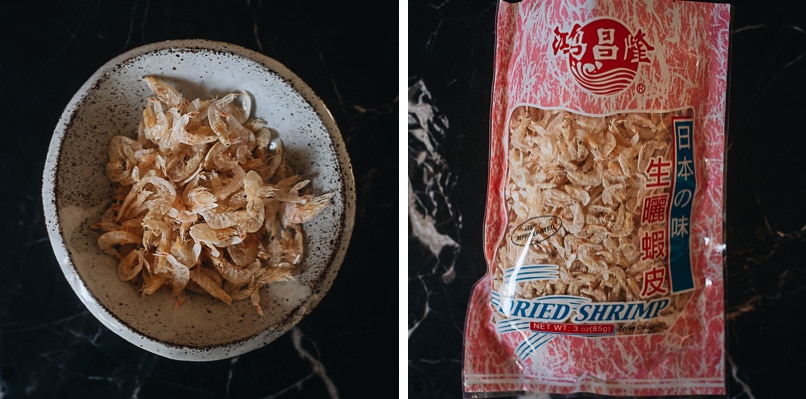
These days you can find papery shrimp on Amazon, but it’s so much cheaper if you can find them at Asian markets.
NOTE: it’s very common to use the regular dried shrimp to make this dish as well. If you only have the regular dried shrimp, pre-soak them for a few hours (to overnight) until they turn tender, then follow the recipe below.
Seasoning and sauce
The stir fry itself mainly uses dried shrimp to create flavor. And I further added mushroom powder (or chicken powder) to boot the taste. It’s a very common practice in Chinese cooking, to create rich-tasting dishes without mixing a stir fry sauce.
I used some cornstarch slurry at the end because winter melon usually releases quite a bit of liquid during cooking. The slurry creates a very thin sauce that lightly coats the veggies and makes the dish less dry. However, if you’re using a wok and a powerful stove, you can probably get away without using the slurry at all, further cutting down on the prep and cooking time.
How to cook winter melon stir fry
In this recipe, I blanched the winter melon before stir-frying it. It creates an even texture that won’t be too hard or too mushy.
Some Chinese cooks prefer to slice the winter melon thinly and stir fry it directly, without blanching, to save time. It’s possible to do so if you have a wok and a powerful stove. But if you’re not careful, the winter melon will be cooked too quickly and turn to a mushy texture.
Cooking process
- Blanch the carrots and winter melon
- Fry the papery shrimp until golden
- Saute the garlic to release the fragrance
- Quickly stir fry the pepper
- Add back blanched carrots and winter melon, then add the seasonings
- Give it a final stir and adjust the seasoning by adding more salt, if needed
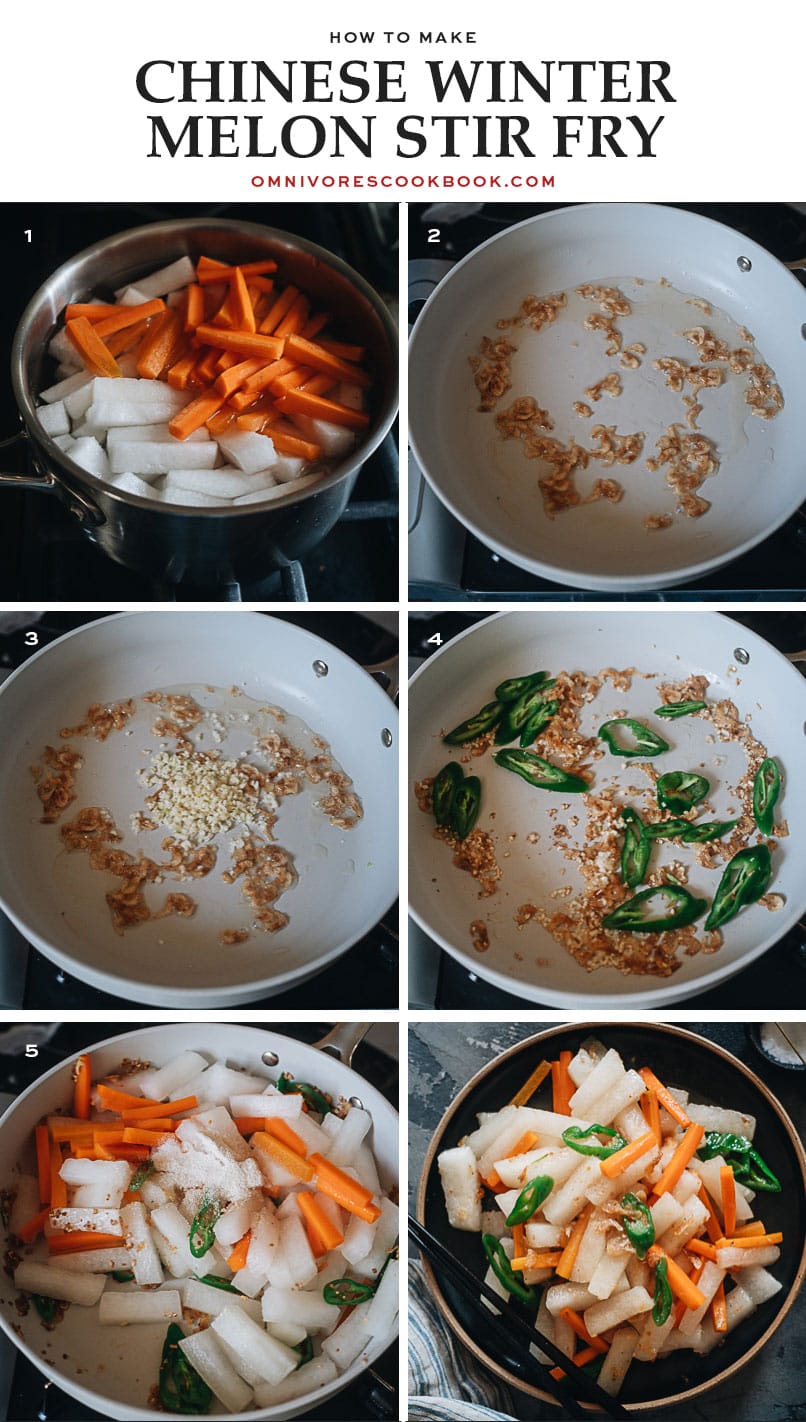
Winter melon is quite hard to come by in the US, so I’ll grab a piece whenever I spot it at an Asian grocery store or farmer’s market. However, I’ve seen more and more people growing it at home. If you’re lucky enough to get your hands on some, I hope this post will help you enjoy it!
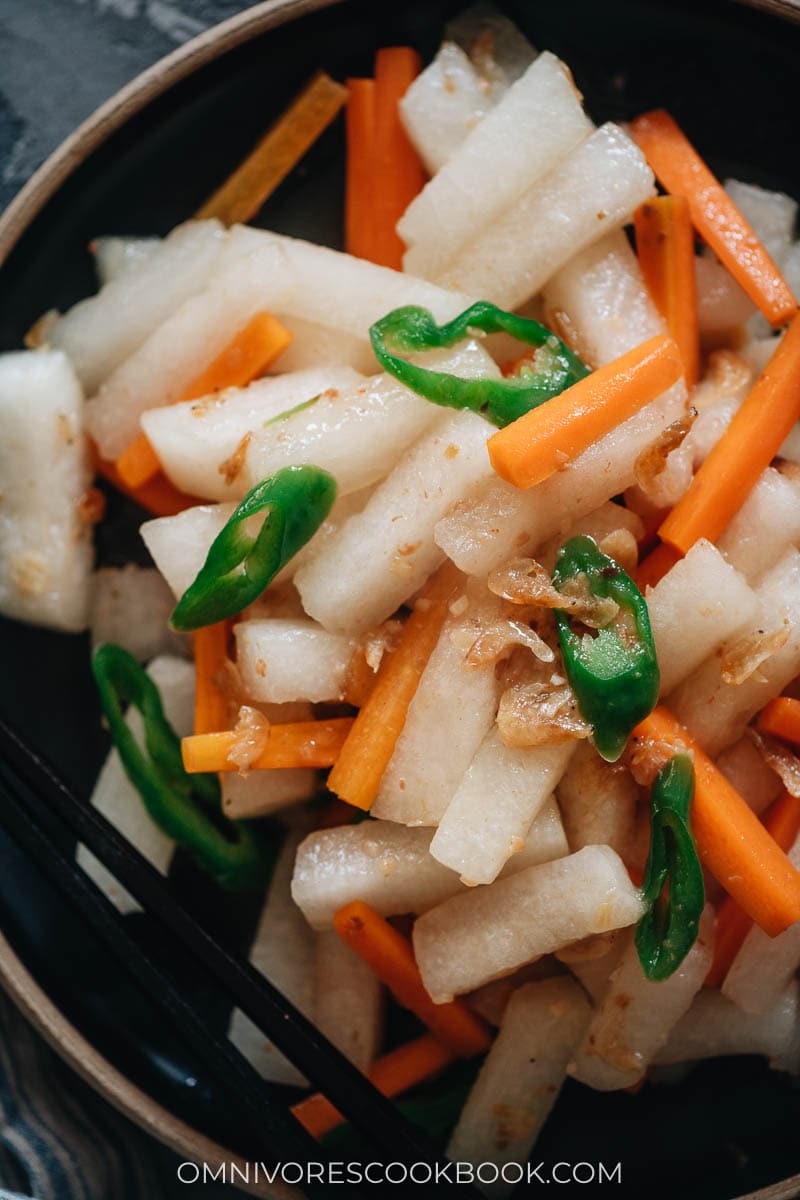
Want to learn more about Chinese Cooking? Sign up for my newsletter to receive the 5-Day Chinese Cooking Crash Course and recipe update!
Chinese Cooking Made Easy
Are you new to this website? This free email series is a great place to start. I’ll walk you through a few of my most popular recipes and show you how and why they work. You’ll quickly start to cook better Chinese food in your own kitchen.
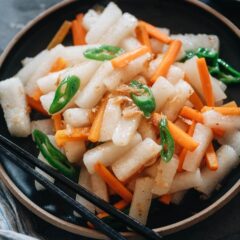
Winter Melon Stir Fry
Ingredients
- 1/2 carrot , cut into 2×1/2” (6×1 cm) batons (about 4 oz) (Optional) (*Footnote 1)
- 1 1/2 lbs (680 g) winter melon , peeled and cut into 2×1/2” (6×1 cm) batons
- 1 tablespoon peanut oil
- 2 tablespoons papery shrimp (*Footnote 2)
- 2 cloves garlic , minced
- 1 long green pepper , sliced (Optional) (*Footnote 3)
- 1/2 teaspoons mushroom powder (or chicken powder) (*Footnote 4)
- 1 teaspoon sugar
- 1/4 teaspoon salt (or to taste)
Slurry
- 1/2 teaspoon cornstarch
- 1 teaspoon water
Instructions
- Combine the cornstarch and water in a small bowl. Stir to mix well and set aside.
- Prepare a large skillet and add about 3” (8 cm) of water. Bring to a boil and add a pinch of salt. Add the carrots and boil for 1 minute. Add the winter melon and boil for another 1 to 2 minutes, until slightly softened but not yet translucent. Drain the cooked vegetables and rinse with cold water to stop the cooking. Drain again and set aside in a big plate.
- Return the pan to the stove and wipe clean with a paper towel. Add the oil and heat over medium heat until hot. Add the papery shrimp. Stir and cook until the shrimp turn golden, 1 minute or so.
- Add the garlic and stir a few times to release the fragrance.
- Add the pepper. Cook and stir for 1 minute.
- Add the blanched carrot and winter melon, mushroom powder, sugar, and a pinch of salt. Stir and cook until the seasonings are evenly distributed and the winter melon turns tender but is not falling apart, 1 to 2 minutes.
- Stir the slurry ingredients again to fully dissolve the cornstarch and pour it over the vegetables. Stir gently until the sauce thickens slightly, 1 minute or so. Carefully taste the winter melon and add more salt, if needed.
- Serve hot as a side dish.
Notes
- I added the carrots to add color. This recipe will still work if you use only winter melon and skip the other vegetables.
- I prefer to add a ton of papery shrimp to add a strong flavor. If you do not wish to add too much seafood taste, you can reduce the shrimp to 1 tablespoon and add 1/2 teaspoon more mushroom powder.
- Mild green pepper adds a bit of spiciness and crisp texture to the dish. It’s totally OK to skip this if you want a milder dish or want to simplify the recipe.
- If you reduce the quantity of papery shrimp, you should add more mushroom (or chicken) powder to add more umami taste.
Nutrition

Did you make this recipe?
I’d love to hear how it turned out for you! Please take a moment to leave a 5-star rating ⭐️ and share your thoughts in the comments further down the page. It really helps others discover the recipe too.
If you give this recipe a try, let us know! Leave a comment, rate it (once you’ve tried it), and take a picture and tag it @omnivorescookbook on Instagram! I’d love to see what you come up with.
More home-style Chinese recipes
- Scrambled Egg with Tomato
- Chinese Shredded Potato Salad
- Leafy Greens with Garlic Sauce
- 4-Ingredient Fried Cabbage
- Bok Choy stir-fry with Crispy Tofu
Lilja Walter is a part of the Omnivore’s Cookbook team and worked closely with Maggie to develop and test this recipe.
